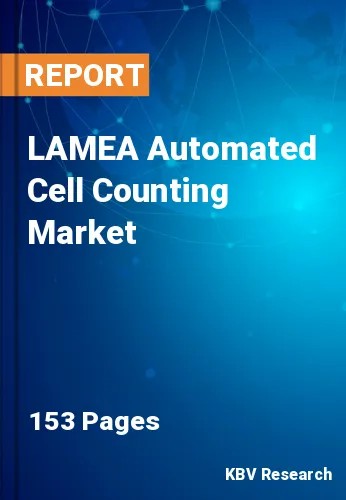The Latin America, Middle East and Africa Automated Cell Counting Market would witness market growth of 14.9% CAGR during the forecast period (2023-2030).
Autonomous cell counters and analysers integrating numerous analytical modalities are experiencing increased market demand. By integrating functionalities such as high-content imaging, cell enumeration, viability testing, and flow cytometry, scientists can extract a greater quantity of data from samples within a single assay. Instruments with multiple techniques increase laboratory output and decrease the instrument's footprint. Miniaturized cell counting systems such as microfluidic cell counters and lab-on-a-chip devices are increasing in research laboratories.
Automated cell counters incorporate smart connectivity technologies, such as USB, Wi-Fi, and Bluetooth interfaces, to facilitate data transmission, storage, and analysis seamlessly. Software platforms enable sophisticated visualization, statistical analysis, archiving, and reporting tools for enhanced data utility. In addition, competitors provide cloud-based and application-based solutions for instrument networking and remote monitoring. The inclination towards smart data systems integrated into connected instruments to optimize cell counting insights is consistent with laboratory automation and digitization processes.
With the growing age, the incidence of age-related diseases such as cancer, neurodegenerative disorders, and cardiovascular conditions increases. This drives the need for accurate cell counting in research, diagnosis, and treatment. Older individuals often have chronic conditions requiring ongoing monitoring and treatment, leading to a higher demand for biologics and cell-based therapies, thus increasing the need for cell counting technology. Consequently, the expanded geriatric demographic in the region is catalysing the development of the market.
The Brazil market dominated the LAMEA Automated Cell Counting Market by Country in 2022 and would continue to be a dominant market till 2030; thereby, achieving a market value of $160.3 million by 2030. The Argentina market is showcasing a CAGR of 15.5% during (2023 - 2030). Additionally, The UAE market would register a CAGR of 14.5% during (2023 - 2030).
Based on Product, the market is segmented into Consumables Accessories, and Instruments (Image-based Cell Counters, Flow Cytometers, Electrical Impendence Coulter Counters). Based on Application, the market is segmented into Cell Line development, Blood Analysis, Stem Cell Research, and Others. Based on End-use, the market is segmented into Pharmaceutical Biotechnology Companies, Hospitals Diagnostic laboratories, Research Academic Institutes, and Others. Based on countries, the market is segmented into Brazil, Argentina, UAE, Saudi Arabia, South Africa, Nigeria, and Rest of LAMEA.
Free Valuable Insights: The Worldwide Automated Cell Counting Market is Projected to reach USD 8.6 Billion by 2030, at a CAGR of 12.2%
The market research report covers the analysis of key stake holders of the market. Key companies profiled in the report include Shanghai Ruiyu Biotechnology Co., Ltd. (Alit Biotech (Shanghai) Co., Ltd.), Thermo Fisher Scientific, Inc., Bio-Rad laboratories, Inc., F. Hoffmann-La Roche Ltd., Danaher Corporation, Olympus Corporation, Merck KGaA, Abbott Laboratories, Sysmex Corporation, and Agilent Technologies, Inc.
By Product
By Application
By End-use
By Country
Our team of dedicated experts can provide you with attractive expansion opportunities for your business.

